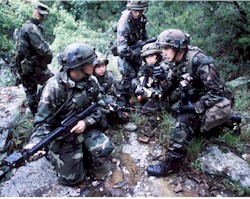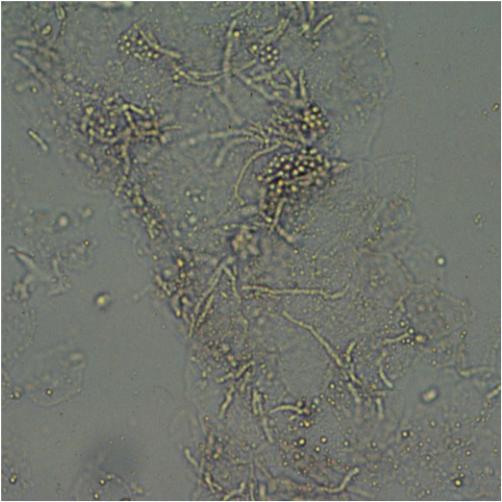Tinea Versicolor
|
Although the diagnosis is usually clinically obvious, a KOH taken from a scaly macule will frequently show the classic "spaghetti and meatballs" pattern of pseudohyphae and spores (figure 14). The goal is to control of the yeast overgrowth on the skin. It can't be eradicated because it is part of the body's normal flora. Selenium sulfide suspension (Selsun) applied to the skin, rinsed after 5-10 minutes for 7-14 days initially then reduced to twice a week will usually suffice. Zinc pyrithione shampoos (e.g. Head and Shoulders) should be used similarly to Selsun. Ketoconazole shampoo is also effective but is relatively expensive. Antifungal creams and lotions (e.g. miconazole, etc.) while effective, are awkward (and expensive) to use over larger areas of the trunk. Oral ketoconazole should not be used as
mono-therapy. This is a common mistake among novice primary care
providers. Although it is very effective in severe cases, it
frequently creates complacency in both the physician and patient. It
is not a long term solution and it should be used, if at all, as a
"starter" therapy and topical therapy should be used for further
treatment. It is merely an optional adjunct to the topical antifungal
therapy above. Although the literature supports a variety of
regiments, one preferred treatment is 200 mg daily for 7 days, taken
on an empty stomach. Written and revised by CAPT Dennis
A. Vidmar, MC, USN, Department of Military and Emergency
Medicine, and Department of Dermatology, Uniformed Services University
of the Health Sciences, Bethesda, MD (1999). Additional images provided by CAPT Vidmar in
June, 2000, subsequent to the initial publication of this manual. |
|
Preface · Administrative Section · Clinical Section
The
General Medical Officer Manual , NAVMEDPUB 5134, January 1, 2000
Bureau
of Medicine and Surgery, Department of the Navy, 2300 E Street NW, Washington, D.C.,
20372-5300
This web version of The General Medical Officer Manual, NAVMEDPUB 5134 is provided by The Brookside Associates Medical Education Division. It contains original contents from the official US Navy version, but has been reformatted for web access and includes advertising and links that were not present in the original version. This web version has not been approved by the Department of the Navy or the Department of Defense. The presence of any advertising on these pages does not constitute an endorsement of that product or service by either the Department of Defense or the Brookside Associates. The Brookside Associates is a private organization, not affiliated with the United States Department of Defense. All material in this version is unclassified. This formatting © 2006 Medical Education Division, Brookside Associates, Ltd. All rights reserved.
Home · Textbooks and Manuals · Videos · Lectures · Distance Learning · Training · Operational Safety · Search
|
|
|
This website is dedicated to the development and dissemination of medical information that may be useful to those who practice Operational Medicine. This website is privately-held and not connected to any governmental agency. The views expressed here are those of the authors, and unless otherwise noted, do not necessarily reflect the views of
the Brookside Associates, Ltd., any governmental or private organizations. All writings, discussions, and publications on this website are unclassified.
© 2006 Medical Education Division, Brookside Associates, Ltd. All rights reserved
Other Brookside Products

